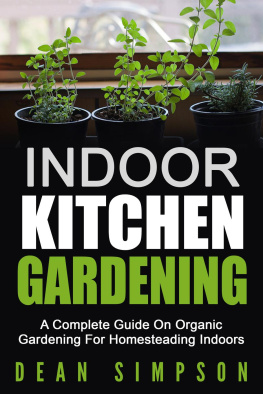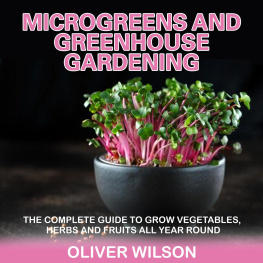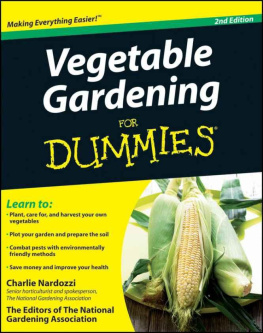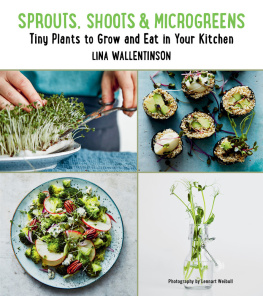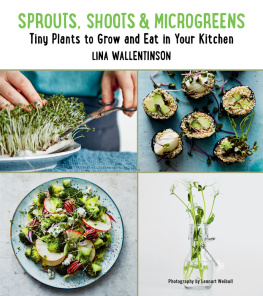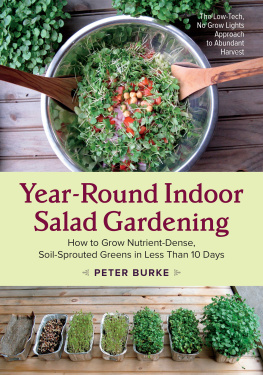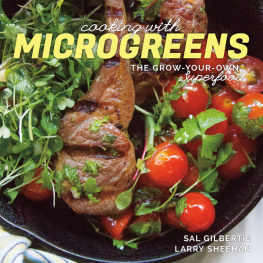INDOOR KITCHEN GARDENING
ELIZABETH MILLARD

First published in 2014 by Cool Springs Press, a member of the Quarto Publishing Group USA Inc., 400 First Avenue North, Suite 400, Minneapolis, MN 55401
2014 Cool Springs Press
All rights reserved. With the exception of quoting brief passages for the purposes of review, no part of this publication may be reproduced without prior written permission from the Publisher.
The information in this book is true and complete to the best of our knowledge. All recommendations are made without any guarantee on the part of the author or Publisher, who also disclaims any liability incurred in connection with the use of this data or specific details.
Cool Springs Press titles are also available at discounts in bulk quantity for industrial or sales-promotional use. For details write to Special Sales Manager at Quarto Publishing Group USA Inc., 400 First Avenue North, Suite 400, Minneapolis, MN 55401 USA. To find out more about our books, visit us online at www.coolspringspress.com.
Digital edition: 978-1-61058-981-9
Softcover edition: 978-1-59186-593-3
Library of Congress Cataloging-in-Publication Data
Millard, Elizabeth.
Indoor kitchen gardening : turn your home into a year-round vegetable garden: microgreens - sprouts - herbs - mushrooms - tomatoes, peppers & more / Elizabeth Millard.
pages cm
Includes index.
ISBN 978-1-59186-593-3 (softcover)
1. Vegetable gardening. 2. Indoor gardening. I. Title.
SB324.5.M54 2014
635dc23
2014000471
Acquisitions Editor: Mark Johanson
Design Manager: Brad Springer
Layout: Mayfly Design
Interior Design: Rob Johnson
Front Cover Design: Rob Johnson
Photography: Crystal Liepa
Contents
G rowing up in Minnesota, my schools always seemed located across from cornfields and farm stands, but wearily gazing outside during math class was about as close as I got to agriculture. Although my great-grandparents and grandparents were farmers, I grew up in the suburbs, a land of uniform lawns and frozen vegetables, and although I deeply appreciated lazing around in trees and watching bees in the neighbors garden, I never imagined Id be spending any time digging, weeding, or talking about compost. The concept of growing food was about as foreign to me as algebra (which I also believed Id never use).
After a few decades in the business world, that sense of disconnection to my food remained, although Id expanded into cooking more meals and using more than one spice at a time. It wasnt until I was in my early 40s, though, that I actually grew anything more than an appetite.
Elizabeth (Bossy E) and Karla (Bossy K) in a rare moment of relaxation at their Community Supported Agriculture (CSA) farm, Bossy Acres, in Minnesota.
When people ask how I got into farming, I like to say that I dated my way into it. I met my future partner, Karla Pankow, during a Habitat for Humanity build in Zambia, Africa, and we joke that our relationship started while we had dirt-encrusted hands, so why not continue the tradition from there? The beautiful simplicity of living therealbeit for only a few weeksstayed with both of us, and we realized that we yearned to create a life focused on sustainability, abundance, gratitude, and plenty of dirt. By launching a farm, Bossy Acres, were off to an excellent start.
Before we first managed to get into our farmland, though, we began by growing a wealth of crops inside. Winter in Minnesota is notorious for wearing optimists down to a brittle nub, but the more experimentation we did with microgreens, pea shoots, radishes, and other tasty vegetables, the more we felt like we were extending summer into our house. As the snow buried the cars outside, we harvested wave after wave of tiny, delicious greens that kept us busy until we could find some fields to tillor at least break into the raised beds in our backyard garden in Minneapolis.
Microgreens and other indoor edibles do more than simply feed the body. They add color and texture to the interior of your home, and watching them grow is an exciting adventure for kids and adults alike.
The experience went against everything Id believed for most of my life: that indoor vegetable growing was for experts who possessed deeply green thumbs, and that anything edible raised inside a house had to be grown in some extensive, costly system. Most of all, I thought having a little two-bedroom bungalow in the city was a huge drawback because I didnt have an expansive kitchen with tons of natural light, or a finished basement with space for rows upon rows of grow lights.
Fortunately, through several seasons of indoor growing, I came to see that there are plenty of options when it comes to in-home farming. Nutrient-rich microgreens, sprouted alfalfa and broccoli, even beets and mushroomswith the right mix of light, airflow, water, and attention, all can flourish as easily as houseplants.
In this book, youll learn the basics of indoor growing, get tips on specific crops, and troubleshoot some common indoor growing issues so that you can easily get started on the leafy, delicious path of in-home gardening. Starting with planning your space, and finding the right area in your home (usually the kitchen, but not always), you can transition to planting, soil conservation, water usage, airflow management, and all those other zesty strategies that go into being an in-home gardener.
Bossy Acres, the Community Supported Agriculture farm operated by Elizabeth and Karla, relies heavily on volunteer field work from CSA members who enjoy getting their hands dirty.
Also included are some ideas on preparing your hard-earned bounty. For several years, I focused so much on growing vegetables that I neglected educating myself on how to actually eat them. Yet, its hugely important to make food prep into a part of any gardening strategy. Thats why Im just as likely to be pickling, fermenting, and chopping as I am weeding, transplanting, and harvesting. There are certainly times where I plant a certain type of vegetable or fruit just to see if it can be done (Im looking at you, artichokes), but at the same time, I make sure to be prepared if my ambitious schemes end up working.
A jar full of a blend of spicy microgreens is weighed and prepared to be sent out for sale at a local farmers market.





